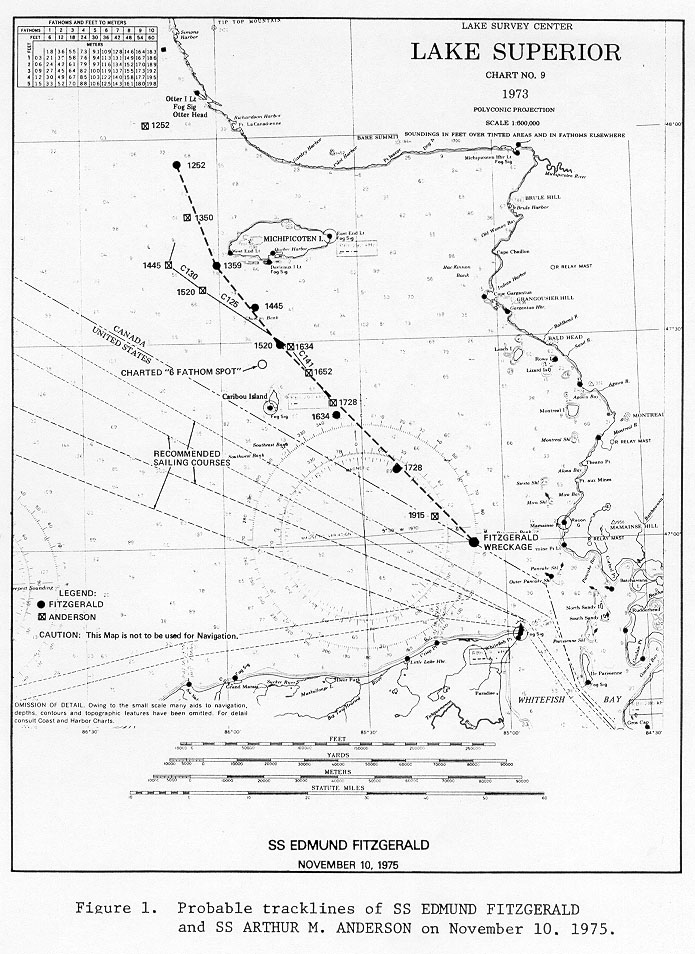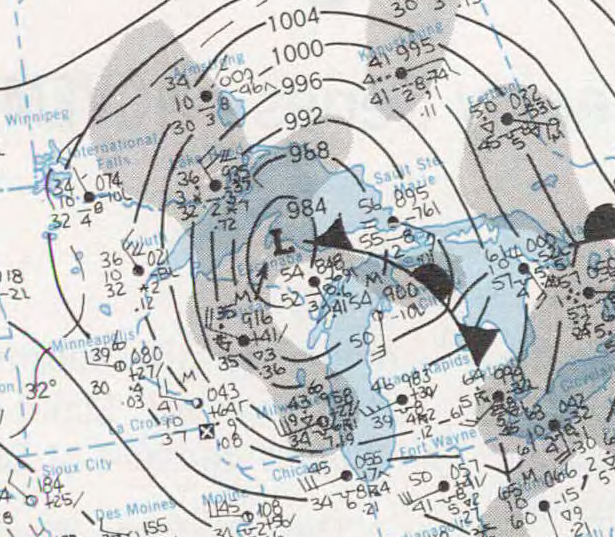There are an estimated 550 shipwrecks laying beneath the surface of Lake Superior. The Edmund Fitzgerald is arguably the most famous Lake Superior shipwreck of them all. It lies 17 miles (27 km) northwest of Whitefish Point, Michigan in Canadian waters 37 miles (60 km) north of Sault Ste Marie, Ontario.

The Edmund Fitzgerald remains the largest ship to have ever sunk in Lake Superior still to this day. A total of 29 lives lost; no bodies were ever recovered. When one looks at a photograph of the ship, it is hard to imagine how a ship of such size and strength could sink in the waves of a Great Lake. It puts into perspective the sheer power of the wind and waves of Lake Superior.
Edmund Fitzgerald History
Launching the Edmund Fitzgerald
The SS Edmund Fitzgerald first launched on June 8, 1958, at River Rouge Michigan. 15,000 onlookers went to see the largest ship on North America’s Great Lakes at the time. The freighter measured 730 feet (22.5 m.) long, 75 feet (22.8 m.) wide, and 39 feet (11.9 m.) high. The ‘Mighty Fitz’ was built to transport taconite iron ore pellets between the mines near Duluth, MN and ports around the Great Lakes. The normal route the ship took was from Silver Bay Minnesota to the steel mills on the lower Lakes in the Detroit and Toledo area.

Though the launch didn’t go off completely without a hitch. The investors of the freighter were Northwestern Mutual Life Insurance Company of Milwaukee and named after its president, Edmund Fitzgerald. Edmund’s wife, Elizabeth was to christen the ship with a champagne bottle, though it took three attempts before it broke on the ship’s bow. The launch was then delayed for over half an hour due to a struggle to release the keel blocks. Once it was finally released, it created a massive wave splashing spectators and crashing into the pier. One man observing the launch unfortunately suffered a heart attack and later passed away. Some thought that all of these events may have been a bad omen for what was to come for the Edmund Fitzgerald.
The Edmund Fitzgerald would spend 17 years on Lake Superior before it met its final fate.
The Storm and Final Voyage
On November 9, 1975, the Edmund Fitzgerald left the Burlington Northern Railroad Dock No.1 in Superior Wisconsin. It was loaded with 26, 116 tons of taconite pellets (processed iron ore in marble sized balls). Aboard was captain Ernest M. McSorley with 28 crew members.

That same day, the “Arthur M. Anderson” ship departed Two Harbors Minnesota. Captain Bernie Cooper was approximately 15 miles behind the Edmund Fitzgerald. He was in radio contact with Captain McSorley. They were both aware of a storm building on Lake Superior.
The captains decided to both take the northern course across Lake Superior because they thought the highlands on the Canadian Shore would protect them. They later took a Southeast turn toward Whitefish Point.

As evening approached the weather conditions got worse. Winds gusted at 50 knots and the waves were 12 to 16 feet high. Gale warnings were issued at 7pm November 9th. On November 10th, early afternoon the Edmund Fitzgerald passed Michipicoten Island, approaching Caribou Island. The Anderson was close behind. The weather was increasingly getting worse. 58 knots, 70 knot wind gusts with 18-to-25-foot waves. It’s hard to imagine what that must have looked and felt like for the men onboard both ships. The fear and emotions must have been extreme.
At 6:55 Captain Cooper and his crew claimed 2 big, massive waves took the bow of the Anderson underwater, but the ship recovered quickly.
“I watched those 2 waves head down the lake towards the Fitzgerald, and I think those were the two that sent him under” – Captain Cooper of the Arthur M. Anderson Ship
7:10pm- Anderson’s First Mate, Morgan Clarke, spoke to the Edmund Fitzgerald on the radio.
7:15pm- The radar signal, or “pip” of the Fitz was gone at 7:22pm, Clarke called the Edmund Fitzgerald. Sadly, there was no response.
The Anderson ship had reached the safety of Whitefish Bay. Captain Cooper was very concerned as the Fitz had vanished from radar and radio. He contacted other ships. No one had heard from or could get a response from the Edmund Fitzgerald. At 8:00pm Captain Cooper expressed his concern again to the Coast Guard.

AT 9:00pm the Coast Guard called the Anderson back to request their assistance in searching for the Edmund Fitzgerald. With great concern and hesitation, Captain Cooper made the decision to risk his ship and crew to look for the Edmund Fitzgerald. Upon their search they discovered 2 lifeboats and some debris, but no sign of survivors or the ship.
Between 10:00pm November 10 and November 14th the Coast Guard conducted an extensive and thorough search. On November 14 a U.S. Navy plane that was equipped with a magnetic anomaly detector, located a strong contact 17 miles North, Northwest of Whitefish Point. Using “Side Screen Sonar” the Coast Guard Cutter Woodrush located 2 large pieces of wreckage in the same area.
The Recovery
May 1976, the Coast Guard Cutter Woodrush did another side scan sonar survey along with the U.S. Navy’s CURV III (Controlled Underwater Recovery Vehicle). The CURV III unit took over 900 photographs of the wreck. The words “Edmund Fitzgerald” were clearly seen on the stern, upside down, 535 feet below the surface of Lake Superior.
 There have been many theories on how the ship sank, including that it struck the poorly marked Fathom Shoal by Caribou Island, but it was never proven. There is no conclusive evidence to this day to determine the cause of the sinking.
There have been many theories on how the ship sank, including that it struck the poorly marked Fathom Shoal by Caribou Island, but it was never proven. There is no conclusive evidence to this day to determine the cause of the sinking.
In January 2006 the Ontario Government put a 500 meter (1640 ft.) area around the shipwreck, protecting it as a “watery grave”. The Canadian Government passed this law making it illegal to dive or remove any items at the site of the Edmund Fitzgerald shipwreck site. It is officially recognized by the Canadian Government as a gravesite. There is a substantial fee of 1 millions dollars to anyone who violates this law.
Commemorating the Edmund Fitzgerald
Great Lakes Shipwreck Museum

On July 4th, 1995 the Great Lakes Historical Society conducted an exhibition along with the National Geographic Society, Canadian Navy, Sony Corporation, and the Sault Ste. Marie Tribe of Chippewa First Nations. This expedition resulted in the recovery of the Edmund Fitzgerald 200-pound Bronze Bell. A replica bell, with the names of the 29 men engraved on it, replaced the original bell on the shipwreck. The original Bell is permanently displayed in Michigan at the ‘Great Lakes Shipwreck Museum’ at the Whitefish Point Lighthouse. The bell is displayed at the request of the families of the lost crew. It serves as a memorial to the 29 lives lost on November 10th in the frigid temperatures of Lake Superior.
Pancake Bay Lookout

This lookout is within Pancake Bay Provincial Park, Ontario. The Pancake Bay or Edmund Fitzgerald Lookout trail leads through lush forest to a set of stairs to the Edmund Fitzgerald Lake Superior Lookout. A platform offers spectacular views of Lake Superior, as far out as Whitefish Point, the resting position of the Edmund Fitzgerald ship.
Split Rock Lighthouse

Every November 10th, the beacon at Split Rock Lighthouse is lit to commemorate the sinking of the Edmund Fitzgerald and all other vessels lost on the Great Lakes. U.S. Coast Guard regulation prohibit the light being used for aiding sea vessels anymore, though the beacon is still turned on occasionally for ceremonial and maintenance purposes.
Alona Bay

Alona Bay Scenic Lookout wayside pull off is situated along the Trans Canada Highway right along Lake Superior. It’s a great spot to stop for a break along the Lake Superior Circle Tour to soak in the views of the lake. An interpretive panel offers details about the nearby sunken Edmund Fitzgerald and the first location of uranium discovered in Canada off of Theano Point.
Marquette Maritime Museum

The Marquette Maritime Museum is associated with the Marquette Harbor Lighthouse. You’ll have the opportunity to explore both the museum and lighthouse and learn about maritime history. The museum includes a display of 19th century Fresnel lenses and various artifacts and exhibits on the Edmund Fitzgerald, ore freighters, World War 2, and the history of Lake Superior shipping.
Museum Ship Valley Camp

This unique Maritime Museum has over 100 exhibits inside its 20,000 square foot cargo hold. Some items exhibited are historical artifacts, paintings, recovered shipwreck items, and two lifeboats from the SS Edmund Fitzgerald wreck. Valley Camp was originally christened the S.S. Louis W. Hill in 1917 and was in service on the Great Lakes for almost 50 years. It was then purchased by Le Sault de Sainte Marie Historical Sites Inc during the city’s tri-centennial celebration in 1968. In the early 70s it was designated a Michigan State Historic Site and placed on the National Register of Historic Places as a historic vessel.
“The Lake it is said, never gives up her dead”
–Lyrics written by Gordon Lightfoot from his ballad ‘The Wreck of the Edmund Fitzgerald’ 1976.






